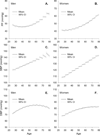Longitudinal perspective on the conundrum of central arterial stiffness, blood pressure, and aging
- PMID: 25225210
- PMCID: PMC4231012
- DOI: 10.1161/HYPERTENSIONAHA.114.04127
Longitudinal perspective on the conundrum of central arterial stiffness, blood pressure, and aging
Abstract
The age-associated increase in arterial stiffness has long been considered to parallel or to cause the age-associated increase in blood pressure (BP). Yet, the rates at which pulse wave velocity (PWV), a measure of arterial stiffness, and BP trajectories change over time within individuals who differ by age and sex have not been assessed and compared. This study determined the evolution of BP and aortic PWV trajectories during a 9.4-year follow-up in >4000 community-dwelling men and women of 20 to 100 years of age at entry into the SardiNIA Study. Linear mixed effects model analyses revealed that PWV accelerates with time during the observation period, at about the same rate over the entire age range in both men and women. In men, the longitudinal rate at which BP changed over time, however, did not generally parallel that of PWV acceleration: at ages>40 years the rates of change in systolic BP (SBP) and pulse pressure (PP) increase plateaued and then declined so that SBP, itself, also declined at older ages, whereas PP plateaued. In women, SBP, diastolic BP, and mean BP increased at constant rates across all ages, producing an increasing rate of increase in PP. Therefore, increased aortic stiffness is implicated in the age-associated increase in SBP and PP. These findings indicate that PWV is not a surrogate for BP and that arterial properties other than arterial wall stiffness that vary by age and sex also modulate the BP trajectories during aging and lead to the dissociation of PWV, PP, and SBP trajectories in men.
Keywords: aging; arteries; blood pressure; longitudinal studies; pulse wave analysis; sex.
© 2014 American Heart Association, Inc.
Figures




References
-
- Najjar SS, Scuteri A, Lakatta EG. Arterial aging: is it an immutable cardiovascular risk factor? Hypertension. 2005;46:454–462. - PubMed
-
- Izzo JL., Jr Arterial stiffness and the systolic hypertension syndrome. Curr Opin Cardiol. 2004;19:341–352. - PubMed
-
- Najjar SS, Scuteri A, Shetty V, Wright JG, Muller DC, Fleg JL, Spurgeon HP, Ferrucci L, Lakatta EG. Pulse wave velocity is an independent predictor of the longitudinal increase in systolic blood pressure and of incident hypertension in the Baltimore longitudinal study of aging. J Am Coll Cardiol. 2008;51:1377–1383. - PMC - PubMed
-
- Liao D, Arnett DK, Tyroler HA, Riley WA, Chambless LE, Szklo M, Heiss G. Aterial Stiffness and the development of hypertension. The ARIC study. Hypertension. 1999;34:201–206. - PubMed
Publication types
MeSH terms
Grants and funding
LinkOut - more resources
Full Text Sources
Other Literature Sources
Medical
Miscellaneous

